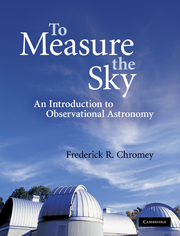11 - Spectrometers
Published online by Cambridge University Press: 05 June 2012
Summary
The dark D lines in the solar spectrum allow one therefore to conclude, that sodium is present in the solar atmosphere.
– Gustav Kirchhoff, 1862This news [Kirchhoff's explication of the Fraunhofer solar spectrum] was to me like the coming upon a spring of water in a dry and thirsty land. Here at last presented itself the very order of work for which in an indefinite way I was looking – namely to extend his novel methods of research upon the sun to the other heavenly bodies.
– William Huggins, 1897Beginning in 1862, Huggins used a spectroscope to probe the chemical nature of stars and nebulae. Since then, spectrometry has been the tool for the observational investigation of almost every important astrophysical question, through direct or indirect measurement of temperature, chemical abundance, gas pressure, wavelength shift, and magnetic field strength. The book by Hearnshaw (1986), from which the above quotes were taken, provides a history of astronomical spectroscopy prior to 1965. Since 1965, the importance of spectroscopy has only increased. This chapter introduces some basic ideas about spectrometer design and use. Kitchin (1995, 2009) and Schroeder (1987) give a more complete and advanced treatment, and Hearnshaw (2009) provides a history of the actual instruments.
Literally, a spectroscope is an instrument to look through visually, a spectrometer measures a spectrum in some fashion, and a spectrograph records the spectrum. Astronomers are sometimes particular about such distinctions, but very often use the terms interchangeably.
- Type
- Chapter
- Information
- To Measure the SkyAn Introduction to Observational Astronomy, pp. 368 - 406Publisher: Cambridge University PressPrint publication year: 2010

